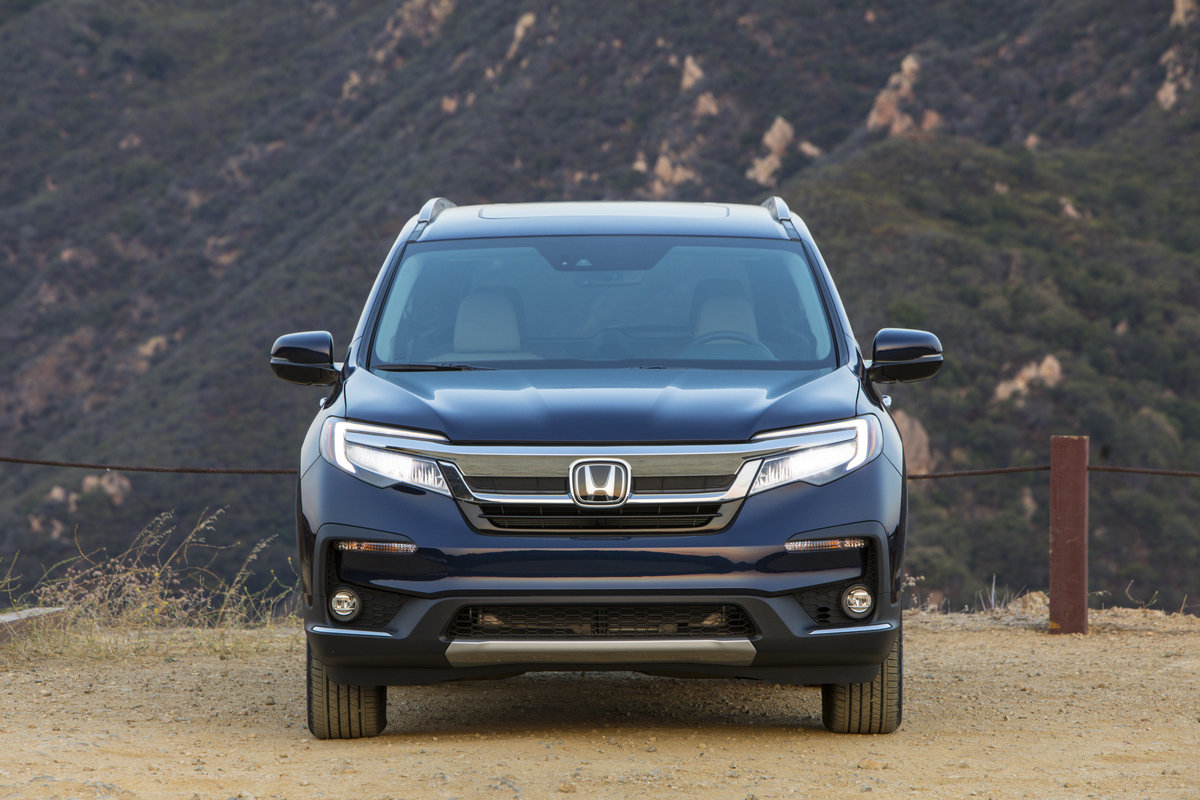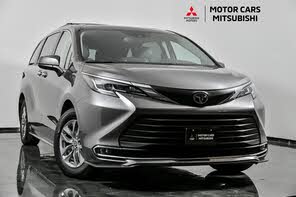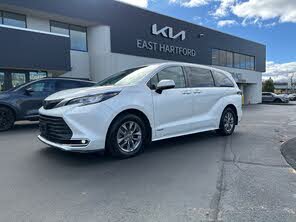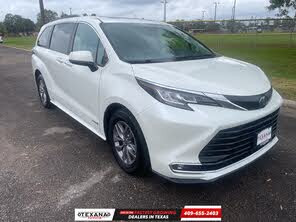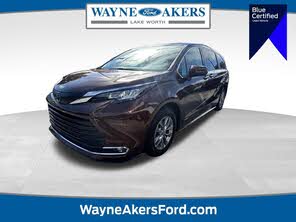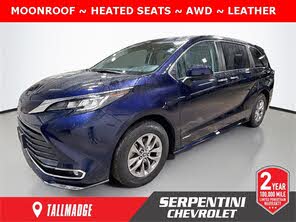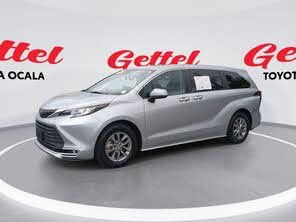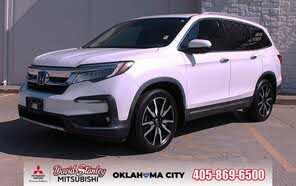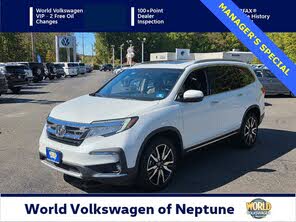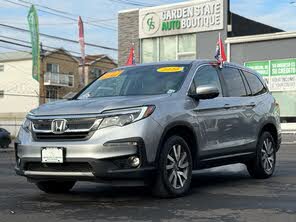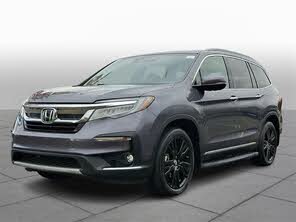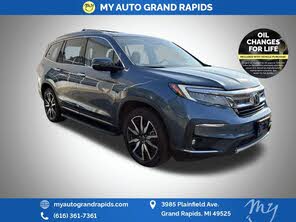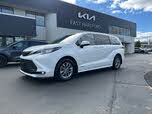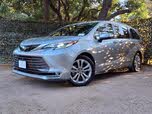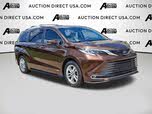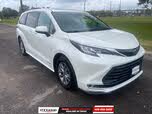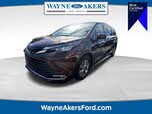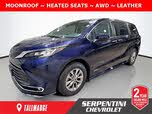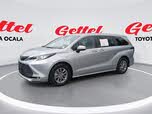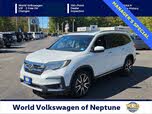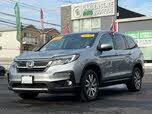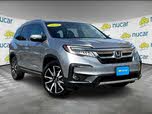2021 Toyota Sienna vs 2020 Honda Pilot
Overview | |
MSRP$31,650 | MSRP$34,460 |
Listings701 | Listings681 |
Ratings & Reviews | |
User Reviews | User Reviews |
Expert reviews8.0 out of 10 | Expert reviews8.3 out of 10 |
Pros
Cons
| Pros
Cons
|
2020 Honda Pilot Reviews SummaryThe Honda Pilot was once the leader of the midsize 3-row SUV pack. But several rivals from Hyundai, Kia, and Mazda have caught up to (and in some cases, surpassed) the Pilot. Still, the Pilot offers tons of cargo space, an adult-friendly third row, and an impressive list of standard safety features. But Honda’s choices on driver controls and in-car tech are its biggest shortcomings. Read on to learn how the Pilot stacks up against the competition, and to learn the CarGurus recommended trim. | |
2021 Toyota Sienna Reviews SummaryToyota’s minivan got a major makeover for 2021, now entering its fourth generation of production since debuting as a 1997 model. For the first time, the Sienna gets a hybrid gasoline-electric powertrain, and not only that—it’s standard equipment. The Sienna Hybrid is built on the Toyota New Global Architecture (TNGA-K) platform, shared with the Highlander and other current Toyota models. | |
No video found | |
Popular Features & Specs | |
Engine3.5L 280 hp V6 | Engine2.5L 245 hp I4 Hybrid |
Drive TrainFWD | Drive TrainFWD |
Seating Capacity8 | Seating Capacity8 |
Horsepower280 hp @ 6000 rpm | Horsepower |
EV Battery Capacity | EV Battery Capacity1.9 kWh |
MPG City19 | MPG City36 |
MPG Highway27 | MPG Highway36 |
Engine | |
Engine Name3.5L 280 hp V6 | Engine Name2.5L 245 hp I4 Hybrid |
Torque262 lb-ft @ 4700 rpm | Torque |
Horsepower280 hp @ 6000 rpm | Horsepower |
DrivetrainFWD | DrivetrainFWD |
Fuel Economy | |
EV Battery Capacity | EV Battery Capacity1.9 kWh |
MPG City19 | MPG City36 |
MPG Highway27 | MPG Highway36 |
Interior | |
Seating Capacity8 | Seating Capacity8 |
Safety | |
Front Crash Overall4 | Front Crash Overall4 |
Side Crash Overall5 | Side Crash Overall5 |
Dimensions & Capacity | |
Cargo Space16.5 cu ft | Cargo Space33.5 cu ft |
Curb Weight4036 lbs | Curb Weight4610 lbs |
Height70.6 in | Height68.5 in |
Length196.5 in | Length203.7 in |
Width78.6 in | Width78.5 in |
Wheelbase111.0 in | Wheelbase120.5 in |
Maximum Payload1509 lbs | Maximum Payload1560 lbs |
Number of doors4 | Number of doors4 |
Maximum Towing Capacity3500 lbs | Maximum Towing Capacity3500 lbs |
Overview | ||
MSRP | $31,650 | $34,460 |
Listings | ||
Ratings & Reviews | ||
User reviews | ||
Expert reviews | 8.0 out of 10Read full review | 8.3 out of 10Read full review |
Pros & cons | Pros
Cons
| Pros
Cons
|
Summary | The Honda Pilot was once the leader of the midsize 3-row SUV pack. But several rivals from Hyundai, Kia, and Mazda have caught up to (and in some cases, surpassed) the Pilot. Still, the Pilot offers tons of cargo space, an adult-friendly third row, and an impressive list of standard safety features. But Honda’s choices on driver controls and in-car tech are its biggest shortcomings. Read on to learn how the Pilot stacks up against the competition, and to learn the CarGurus recommended trim. | Toyota’s minivan got a major makeover for 2021, now entering its fourth generation of production since debuting as a 1997 model. For the first time, the Sienna gets a hybrid gasoline-electric powertrain, and not only that—it’s standard equipment. The Sienna Hybrid is built on the Toyota New Global Architecture (TNGA-K) platform, shared with the Highlander and other current Toyota models. |
Video | No video found | |
Popular Features & Specs | ||
Engine | 3.5L 280 hp V6 | 2.5L 245 hp I4 Hybrid |
Drive Train | FWD | FWD |
Seating Capacity | 8 | 8 |
Horsepower | 280 hp @ 6000 rpm | |
EV Battery Capacity | 1.9 kWh | |
MPG City | 19 | 36 |
MPG Highway | 27 | 36 |
Engine | ||
Engine Name | 3.5L 280 hp V6 | 2.5L 245 hp I4 Hybrid |
Torque | 262 lb-ft @ 4700 rpm | |
Horsepower | 280 hp @ 6000 rpm | |
Drivetrain | FWD | FWD |
Fuel Economy | ||
EV Battery Capacity | 1.9 kWh | |
MPG City | 19 | 36 |
MPG Highway | 27 | 36 |
Interior | ||
Seating Capacity | 8 | 8 |
Safety | ||
Front Crash Overall | 4 | 4 |
Side Crash Overall | 5 | 5 |
Dimensions & Capacity | ||
Cargo Space | 16.5 cu ft | 33.5 cu ft |
Curb Weight | 4036 lbs | 4610 lbs |
Height | 70.6 in | 68.5 in |
Length | 196.5 in | 203.7 in |
Width | 78.6 in | 78.5 in |
Wheelbase | 111.0 in | 120.5 in |
Maximum Payload | 1509 lbs | 1560 lbs |
Number of doors | 4 | 4 |
Maximum Towing Capacity | 3500 lbs | 3500 lbs |
The 2020 Pilot boasted dynamic styling typical of the Honda lineup. With its thin LED headlights and a multi-tiered grille, the Pilot presented a more svelte look than its actual size suggested, due in part to the subtle uptick in the belt-line around the rear side windows. The interior was modern, featuring a semi-digital instrument panel where fuel and engine-temperature gauges were analog, but most other information was found on a digital screen ahead of the driver. Despite hard plastics being used in various places, the cabin felt spacious and comfortable. The trim options spanned from the base LX to the luxurious Black Edition, each adding more advanced features such as Smart Entry, leather upholstery, and even heated and ventilated front seats.
On the other hand, the 2021 Sienna aimed to change the perception of minivans with more SUV-like styling. It featured a wide grille and sleek LED headlamp arrays horizontally integrated into a panel housing the Toyota logo. From the side, the Sienna had an assertive stance with sliding doors sculpted to bulge over the rear wheels. It offered alloy wheels in sizes ranging from 17 to 20 inches depending on trim. The well-finished interior emphasized width with horizontal lines on the dashboard and a clever center console that provided ample storage. The second and third rows were comfortable for adults, with the second row being particularly flexible with its sliding feature.











The Pilot's performance relied on a robust 3.5-liter V6 engine producing 280 horsepower and 262 pound-feet of torque. This power was delivered to the front wheels or an optional all-wheel-drive system. Lower trims featured a 6-speed automatic transmission, while higher trims received a more refined 9-speed automatic. Though the button-operated shifter setup was unconventional and less intuitive, the V6 engine offered strong acceleration suitable for real-world driving. The Intelligent Traction Management System allowed drivers to select Normal, Snow, Mud, and Sand modes, though it didn’t make the Pilot a serious off-roader.
The 2021 Sienna, as Toyota’s first hybrid minivan, combined a 2.5-liter four-cylinder engine with two electric motors to deliver a total of 243 horsepower. The hybrid system featured an electronically controlled CVT, which, while maximizing fuel efficiency, did blunt throttle response somewhat. The Sienna Hybrid offered selectable drive modes including Normal, EV, Eco, and Sport. Thanks to the TNGA platform, it had improved handling with new front suspension and an independent rear suspension, providing a comfortable ride. Its standout feature was its fuel efficiency, with an impressive 36 mpg city/highway/combined for FWD models, and slightly less for the AWD versions.
The Pilot accommodated up to eight passengers with second-row bench seats, while opting for bucket seats in higher trims reduced capacity to seven. The adult-friendly third row and one-touch fold-down rear seats on EX trims made access easy. The Pilot provided 83.9 cubic feet of cargo space with the rear seats folded, slightly less than some competitors but still ample. It included several storage spaces suitable for family use, inspired by the Honda Odyssey minivan.
In contrast, the Sienna showcased its flexibility as a minivan, accommodating passengers and cargo with ease. It offered a 60/40-split third-row seat that stowed easily into the floor and a second row that could slide up to 25 inches. Cargo capacity varied with the positioning of the seats, offering 33.5 cubic feet behind the third row, 75.2 cubic feet behind the second row, and a whopping 101 cubic feet behind the first row. The hybrid battery was cleverly hidden under the front seats, impacting cargo space minimally. Additionally, power-operated sliding doors and a tailgate that responded to kick motions highlighted its emphasis on convenience.
The Pilot's technology package included a 5-inch color LCD screen in the base LX trim, operating a 215-watt stereo system. Higher trims featured an 8-inch touchscreen infotainment system with Apple CarPlay and Android Auto. However, its user interface lacked intuitiveness, and the absence of a tuning knob made radio operation cumbersome. The Touring, Elite, and Black Edition trims offered added luxuries such as navigation, a rear-seat entertainment system, and an upgraded 590-watt audio system.
The Sienna integrated a wealth of technology, starting with a standard 9-inch touchscreen across all trims. It supported Apple CarPlay, Android Auto, and Amazon Alexa, with additional USB ports for charging. Higher trims came with enhanced connectivity options, including a JBL Premium Audio system and a rear-seat entertainment system. Tech-savvy drivers benefitted from features like a 7-inch multi-information display, a 10-inch Head-Up Display in Platinum trims, and a digital rearview mirror in top trims, which provided a clear view regardless of passenger obstructions.
The Pilot came standard with HondaSensing, including forward-collision avoidance, automatic emergency braking, lane-departure warning, adaptive cruise control, and automatic high beams. The Pilot received a five-star overall rating from the NHTSA and top safety scores from IIHS, underscoring its robust safety features.
The Sienna Hybrid was equipped with Toyota Safety Sense 2.0, featuring dynamic radar cruise control, lane-tracing assist, pre-collision systems, and more. It also included 10 airbags, LATCH connectors for child seats, a tire pressure monitoring system, and an improved spare tire location. Although 2021 crash-test ratings were not available at the time, the 2020 model had good ratings from IIHS and a five-star rating from NHTSA, suggesting a high level of safety.
CarGurus highlights
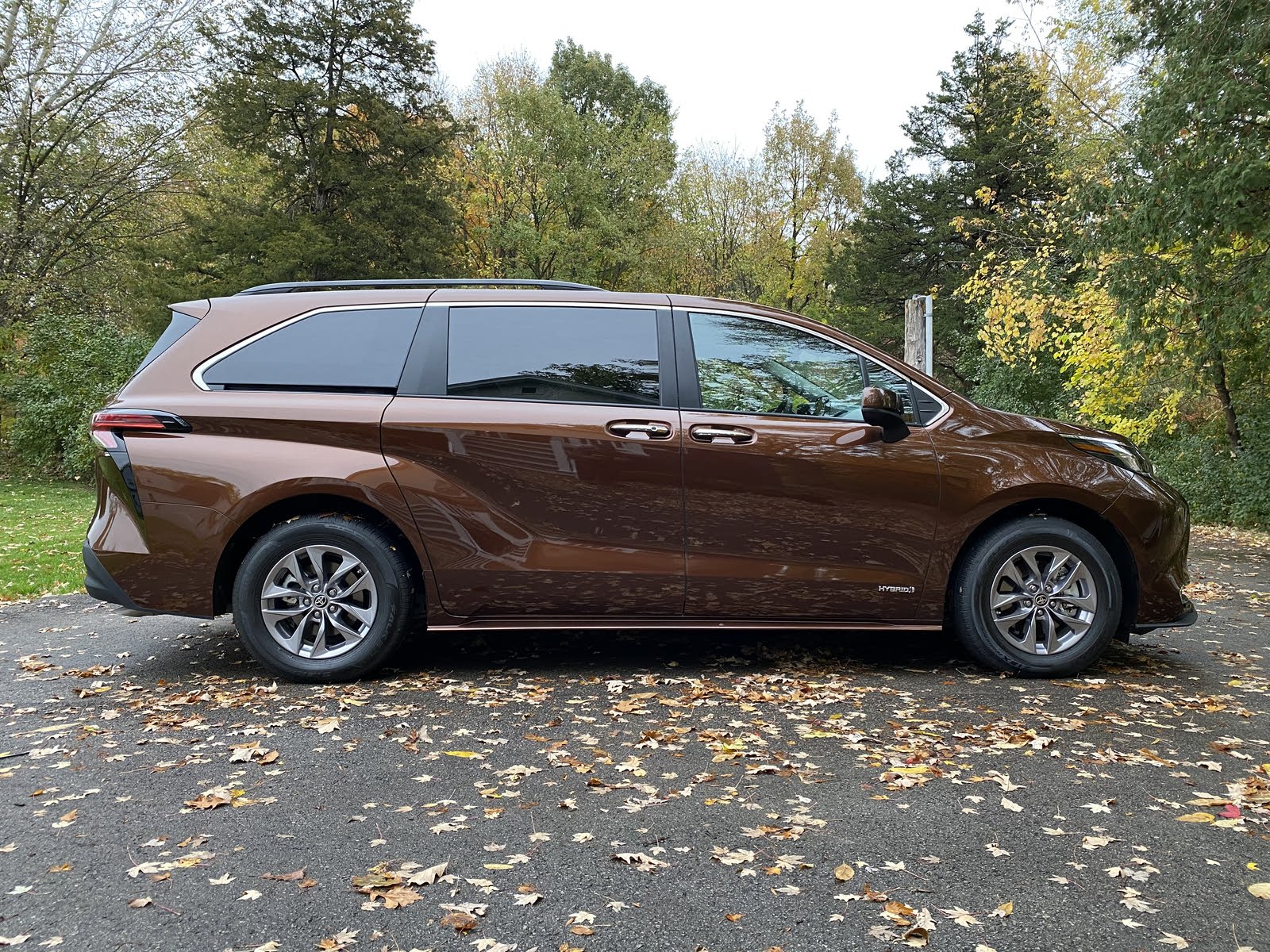
According to CarGurus experts, the overall rating for the 2020 Honda Pilot was 8.0 out of 10, while the 2021 Toyota Sienna scored 8.3 out of 10. Given these scores, the Toyota Sienna stands out slightly above the Honda Pilot. Its superior fuel efficiency, advanced technology, and versatile cabin functions make it a great choice for modern families seeking a reliable and feature-rich minivan.
Choose the 2021 Toyota Sienna if:
- You prioritize excellent fuel economy in a versatile hybrid powertrain.
- You need ample cargo space with flexible seating arrangements for family and personal use.
- You appreciate modern, comprehensive technology packages with advanced safety features.
Choose the 2020 Honda Pilot if:
- You prefer a powerful V6 engine with straightforward, reliable performance.
- You need a practical family vehicle with adult-friendly third-row seating.
- You value a variety of trim options with features that increase in luxury and convenience.
CarGurus highlights

According to CarGurus experts, the overall rating for the 2020 Honda Pilot was 8.0 out of 10, while the 2021 Toyota Sienna scored 8.3 out of 10. Given these scores, the Toyota Sienna stands out slightly above the Honda Pilot. Its superior fuel efficiency, advanced technology, and versatile cabin functions make it a great choice for modern families seeking a reliable and feature-rich minivan.
Choose the 2021 Toyota Sienna if:
Shop Now- You prioritize excellent fuel economy in a versatile hybrid powertrain.
- You need ample cargo space with flexible seating arrangements for family and personal use.
- You appreciate modern, comprehensive technology packages with advanced safety features.
Choose the 2020 Honda Pilot if:
Shop Now- You prefer a powerful V6 engine with straightforward, reliable performance.
- You need a practical family vehicle with adult-friendly third-row seating.
- You value a variety of trim options with features that increase in luxury and convenience.

By: CarGurus + AI
At CarGurus, our team of experienced automotive writers remain at the heart of our content operation, conducting hands-on car tests and writing insightful guides that are backed by years of industry experience. To complement this, we are harnessing AI to make our content offering more diverse and more helpful to shoppers than ever. To achieve this, our AI systems are based exclusively on CarGurus content, ratings and data, so that what we produce is both unique to CarGurus, and uniquely helpful to car shoppers.
